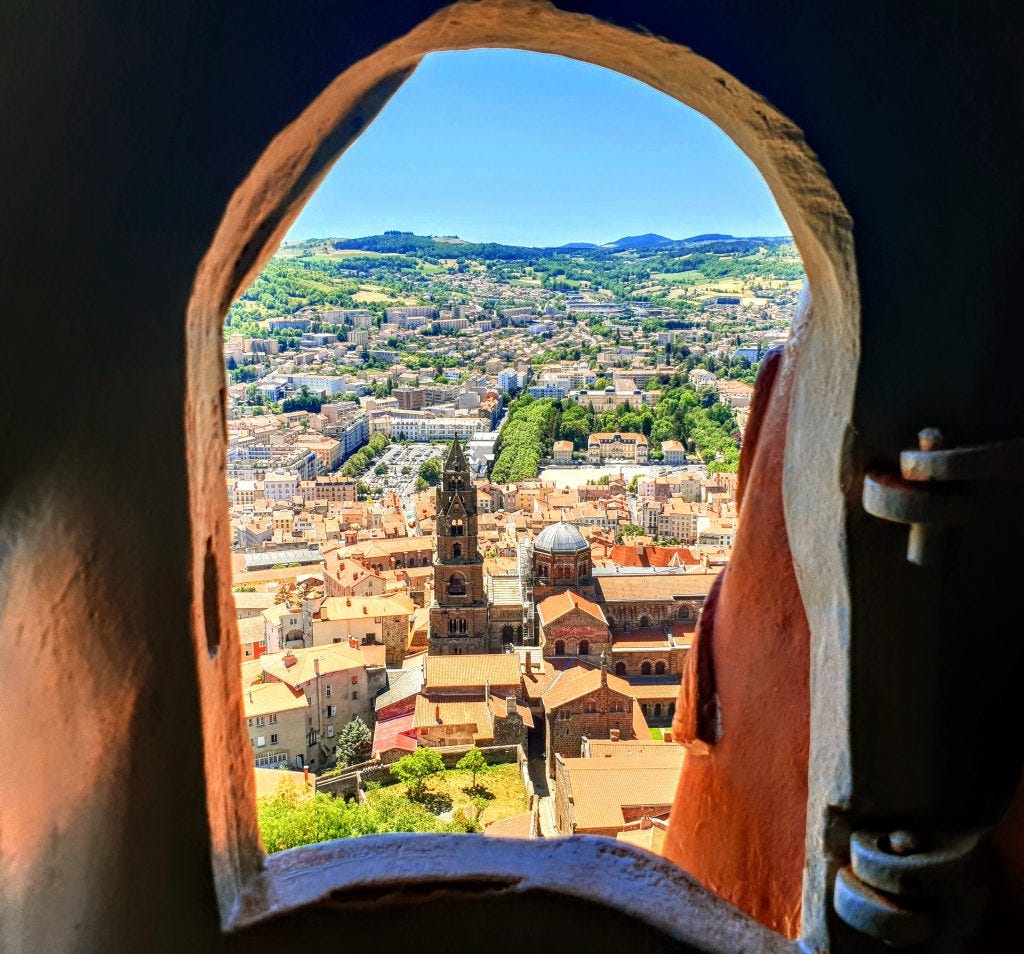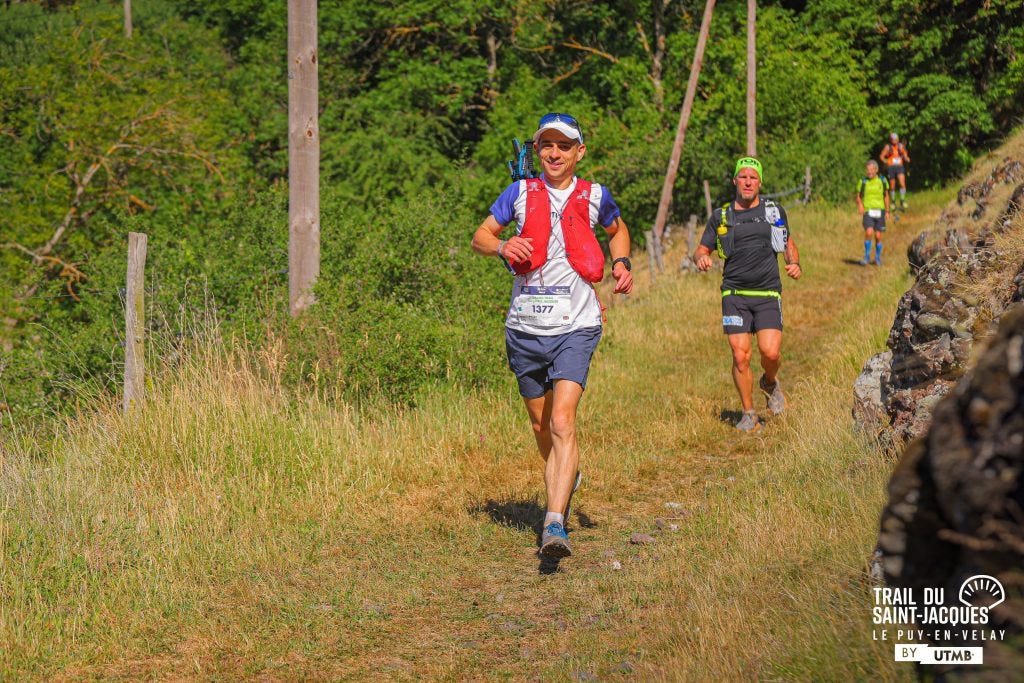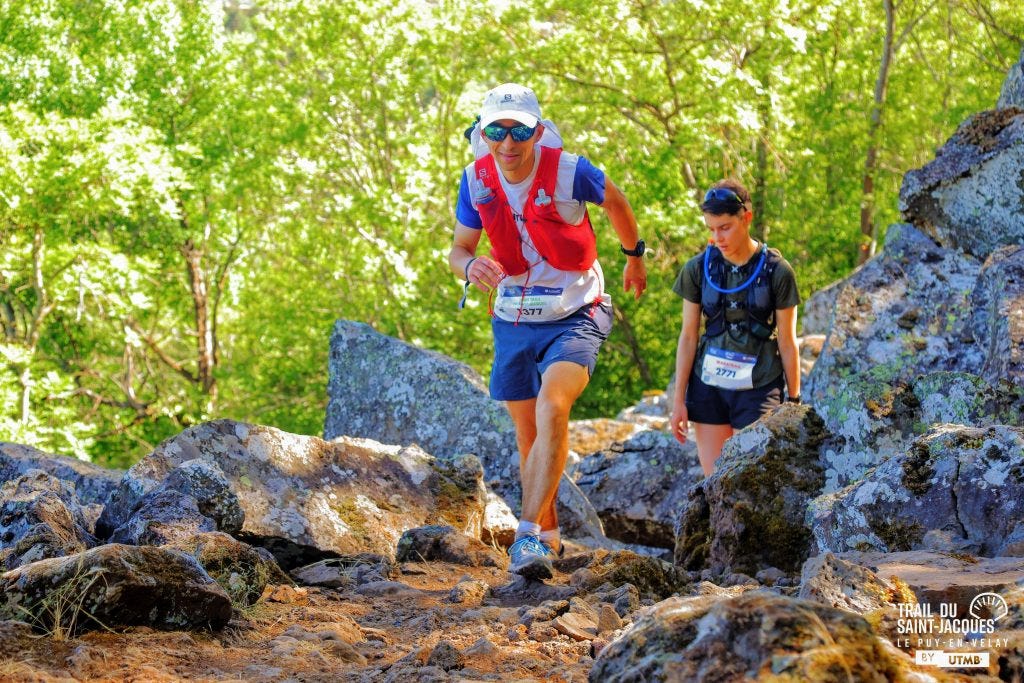Grand Trail du Saint Jacques
“Je dois… visiter… l’église”, I stuttered, practicing my pigeon French. I was being driven in a carpool, by quite possibly the world’s friendliest driver, who had been pointing out some of the local tourist attractions as he conveyed me to my apartment. The 10th century chapel towering above us, perched atop some sort of rocky outcrop, was simply mesmerising, and I would definitely be visiting it. But that wasn’t why I was here.
Since UTMB sparked controversy by joining forces with Ironman, side-lined the ITRA, and required participants to run “by UTMB” races to obtain their proprietary “Running Stones”, some runners have simply turned their back on it. I may not be entirely happy with this new state of affairs either; but the fact is I still want to run the full UTMB, and so I was in the market for a few extra UTMB Running Stones to top-up my ballot entry. The Trail du Saint Jacques ‘by UTMB’ race was the lowest carbon footprint option available to me, in the time window I had.
It was only a short flight to Lyon, from which I was able to use public transport and carpooling to transit to Le Puy en Velay: the site of the race registration, its finish, and as I’d learned, this quite astonishing chapel.
My first impressions of Le Puy en Velay were that of entering a bygone era of cobbled streets, stone architecture, cathedrals and statues. The old town is extensive, and dates back over a millennium. The ancient chapel of St Michel is visible for miles around, due to its baffling siting: perched high, atop a rocky volcanic mound. It practically begs to be climbed, as pilgrims have done for many hundreds of years.
So, climbing up to the chapel was my first priority. I pulled on my UTMB t-shirt from 2021, and dug out my trusty Inov-8 RocLites. My Inov-8 RocLites, without any insoles. Eh? I stared at my alien-looking shoes. Where were the insoles?
I had packed my case the day before, and I’d packed my newer pair of RocLites, which I save for races. In a rush, I obviously hadn’t spotted that I’d removed the insoles for cleaning – probably after the Arc of Attrition – and now I only had the bare shoes with me. This didn’t bode well for a 74k race with 3k+ of ascent.
I put them on all the same, but if you’ve ever tried removing the insoles from your running shoes and running in them (which I doubt – why would you?), you’ll know that it’s not a very comfortable experience. I desperately needed a solution. As I stumbled onto Le Puy en Velay’s main street, wondering where on earth I’d find running shoe insoles in this small town, I squinted at the shop facade directly opposite: Natur Running. I couldn’t have asked for better. Within minutes, I had my shoes fixed up, and I was happily bounding along toward St Michel’s chapel.
When one ascends its historic steps and enters the cool shade of the quaint, asymmetric, painted stone interior, one is instantly transported back to the time of the pilgrims. Considering the demanding physical journey they took to reach this place, and the spiritual journey they must have embarked upon within its stone walls, one felt a real sense of privilege to be able to glimpse into and reflect upon their experience.
Gazing out from the chapel, one’s eyes can’t help but fall upon another impressive monument overlooking the city: the terracotta-coloured statue of Virgin Mary, perched on a second rocky pinnacle. Again, one is practically compelled to ascend it.
To my surprise, ascending to the base of the statue was only half the journey. One can also climb up inside the statue itself. The views overlooking the cathedral, and the rest of Le Puy, are a sight to behold.
The extent of the old town becomes apparent when one starts to run around its cobbled streets. Beautifully maintained throughout, it’s obvious the residents harbour a deep sense of pride in their town, and rightly so. Cafes, brasseries, and independent art and craft shops abound. Whilst plant-based visitors will struggle with the traditional French focus on viande and fromage, there are some traditional restaurants that offer a vegetarian dish which they can adapt on request. There’s also PokéPonot, which offers delicious and nutritious poke bowls for both lunch and dinner. Suffice to say I was a regular there throughout my stay.
Whilst meandering through the cobbled streets, soaking up the meditative ambience of this ancient town that practically oozed historical charm, I began to stumble upon preparations for Trail du Saint Jacques. The race was tomorrow. It was time to collect my “dossard”, and get an early night’s sleep, ready for the early start.
Being so early in the morning, it was rather cold, so I donned a pullover, and set off on foot to catch the coach to the start of the race. As I traipsed through the old town, I picked up a series of French runners heading the same way, and we happily chatted away in Frenglish (I mangled my few words of pigeon French, whilst they responded in near-perfect Queen’s English).
The coach journey to a race start is one of the best parts of a race experience. People fumble aimlessly with their phones, stare out the window, close their eyes. Nobody speaks. There’s an exciting tension in the air, as everybody looks forward to the adventure ahead.
The coach pulled into a lay-by along the main road through the small town of Monistrol, which is nestled in a stunning forested valley. We set off down the hill through the winding residential streets, and eventually came upon what looked like the race start. Some frantic French conversation ensued (of which I understood precisely nil), lots of runners shook their heads, and we turned around and retraced our steps back up the hill. Eventually we peeled off into an unsigned building that it transpired was the welcome venue. There was one modest room with some tables, chairs and volunteers offering coffee, and one toilet. We crammed into the room, found a bit of floor space to sit down, and waited – there was an hour to kill.
With about 20 minutes left before race start, and the room having mostly emptied, I decided to make my way back to the start line to deposit my bag. Casually retracing my steps, I was surprised to see just a handful of volunteers there, who directed me through and onwards. The start line wasn’t the start line after all, it was a timing checkpoint of sorts.
It was almost a 10 minute walk back up to and along the main road, and down the southern side to the actual start line beside the Allier river, where most of the runners were already congregated. With little more than 5 minutes to go before race start, the starting pen was already jam-packed, and I couldn’t make any headway through the crowd. I resigned myself to a poor starting position. That was when I noticed the line of tape ahead of me, which I instinctively pulled over my head, and reasoned this probably meant I was at the very back of a first starting wave. There was nothing I could do.
The race started with some fanfare, but I was preoccupied with my starting position. It took a while to cross the line, and longer still before I could start any sort of running. I did what I could to forge a path past runners through Monistrol, but within minutes I was stuck in queues at the base of the first single track ascent.
The first section of the Grand Trail du Saint Jacques wends its way up and down the hillsides rising from the Allier river, which are plastered with dense forest: a vibrant, dark green carpet so uncommon in England, which has been almost entirely deforested.
Frequently steep and occasionally slippery, most people sensibly use poles to stabilise themselves on the ascents. There are some places suitable for overtaking, but there are also plenty of bottlenecks. I just couldn’t make the sort of progress I wanted to. It was intensely frustrating, especially given the morning was cool and perfect for making good time, before the debilitating heat the afternoon was predicted to bring.
By the first CP at 8k, I had managed to overtake more than half of the first wave, and was in 93rd position. Aside from grabbing a piece of banana, I wasted no time, as this was a prime opportunity to jump more runners without needing to wait for a suitable spot to overtake.
By CP2 I had taken another 13 places, and by CP3, another 22 places. I had managed to get myself into a better position now with fewer queues and bottlenecks, but my haste at the aid stations and my absolute focus on overtaking had taken its toll. From 35km, I began to struggle. I clung on, intermittently holding position or making gradual gains, until the fourth CP at Lac du Bouchet, a little over marathon distance in.
I allowed myself an extra minute here to take on plenty of water, leaving in 40th place. I knew that in about 8km, I’d hit the elevation peak of the route, after which it’d mostly be downhill thereafter. But first I had to get through the remaining climbs, in increasingly warm conditions. I attached the neck shade to my cap in preparation, and battled on up the occasionally steep hillsides beneath the tree canopy.
Reaching 50k was a nice milestone, where the course quite obviously peaks. The hilly, forested landscape makes way for sweeping plains and fields: faster running, but notably unshaded from the midday sun and 30C heat. I was starting to run low on water, but dared not stop at any of the public water fountains so as not to lose any more time.
It was becoming difficult to judge one’s progress relative to other runners, as I was now deep in the throngs of competitors from the other race distances. I was passing Ultra Trail runners who’d been out running since the previous evening; but also marathon, and 32km competitors. With the race bibs on people’s fronts, it was often hard to tell who was who when passing. From what I could make out, though, the Ultra Trail runners looked easily the most broken, but were resigned to their pain and thoroughly determined, often using black humour to help them through. The marathon distance runners looked far less worn, but many I saw were clearly hot, probably dehydrated and possibly underfuelled.
Making reasonable time over the flatter, simpler terrain, I kept my eye out for the iconic symbols of Le Puy en Velay I’d visited the day before: the chapel of St. Michel perched incredibly atop its own extinct volcano, and the imposing terracotta statue of Mary and child overlooking the city. I couldn’t see them.
Pulling into the final aid station, which pre-race I had noted was 4km from the finish, I spotted a sign that said it was actually 5km to the finish. It’s funny how little discrepancies like that, which are utterly inconsequential relative to the race distance, can play on one’s mind at the time. Wanting to come in comfortably under 10h, I set off again in a rush. It wasn’t long before I came across a ‘5km to go’ sign. Déjà vu?
I plodded along through the unrelenting heat, as my Garmin beeped away ticking off the kilometres, and I wondered where on earth the 4km sign was. It came, eventually, and was followed very shortly by the 3km sign just a few hundred metres further along. At that point, I grinned and relaxed back into the race: I had no idea how much further really remained, and I realised I didn’t care. The weather was delightful, the scenery was lovely, and sooner or later I’d emerge into the enigmatic old town of Le Puy en Velay for a race finish. What could be better?
In the end, the descent into the city itself, where I finally saw the chapel I’d been looking for looming ahead, took me by surprise. I cruised through the streets, was guided across the main road by the local gendarmerie, and cheered on by pockets of supporters, until the route swung to the right for the final climb up the iconic cobbled street toward the cathedral. Flanked by UTMB banners and a pleasing complement of spectators, the finish was a classy affair.
I’d finished in 23rd place, with my highest UTMB index to date, and this was despite my hampered starting position. Even in that final 5k, I had made up 8 places. It felt like a good bounce-back from my DNF at Crawley a couple of months prior.
There was nothing else to do, other than head back to PokéPonot for a couple of well-earned poke bowls. So, how was the ‘by UTMB’ experience?
Pretty good. Sure; it wasn’t quite as polished, or memorable, as the Chamonix valley experience. And relative to local races, there’s no denying the increased carbon and financial footprints. But it was a well organised, perfectly marked, high quality race through lovely scenery, with more supporters than I had expected. Overall, a very positive experience which I’m sure will only improve further over time.
The post Grand Trail du Saint Jacques appeared first on The Trail Explorer.









